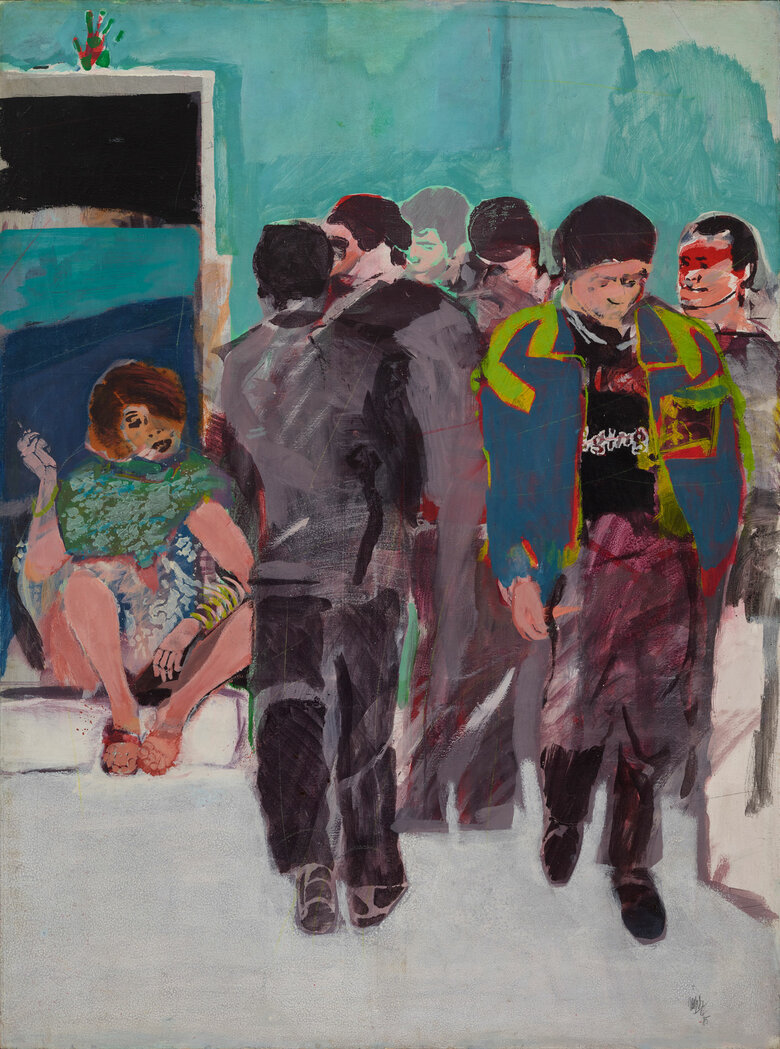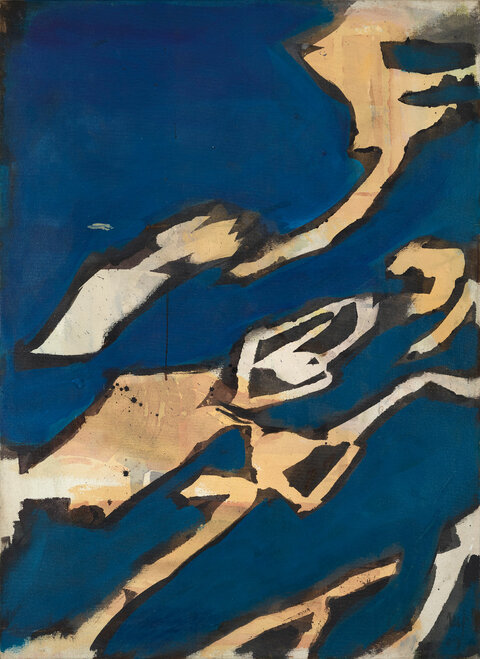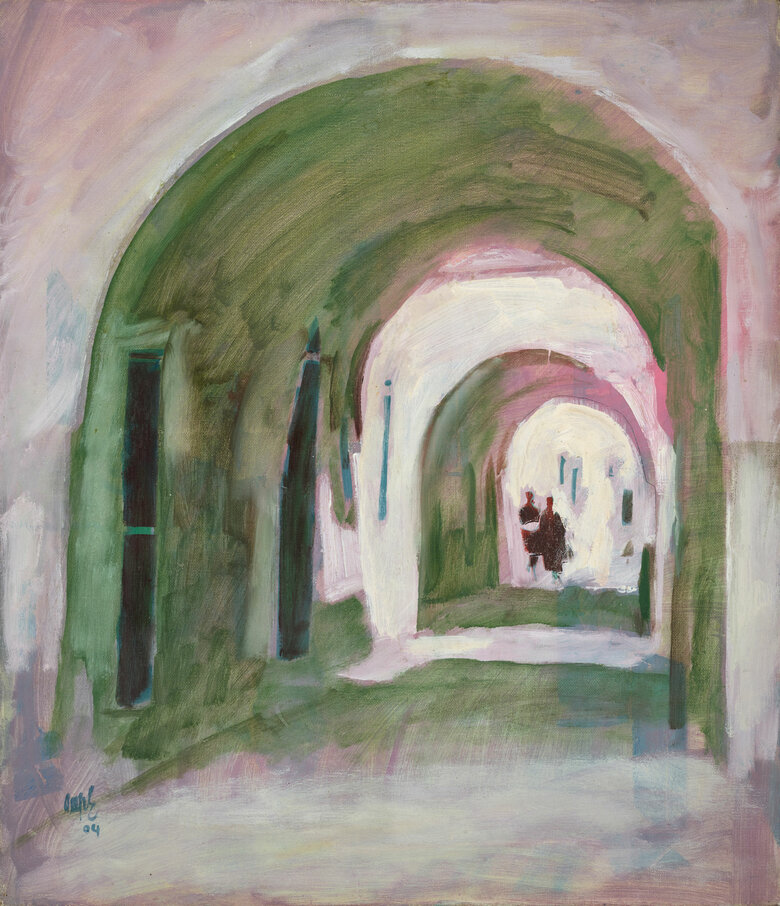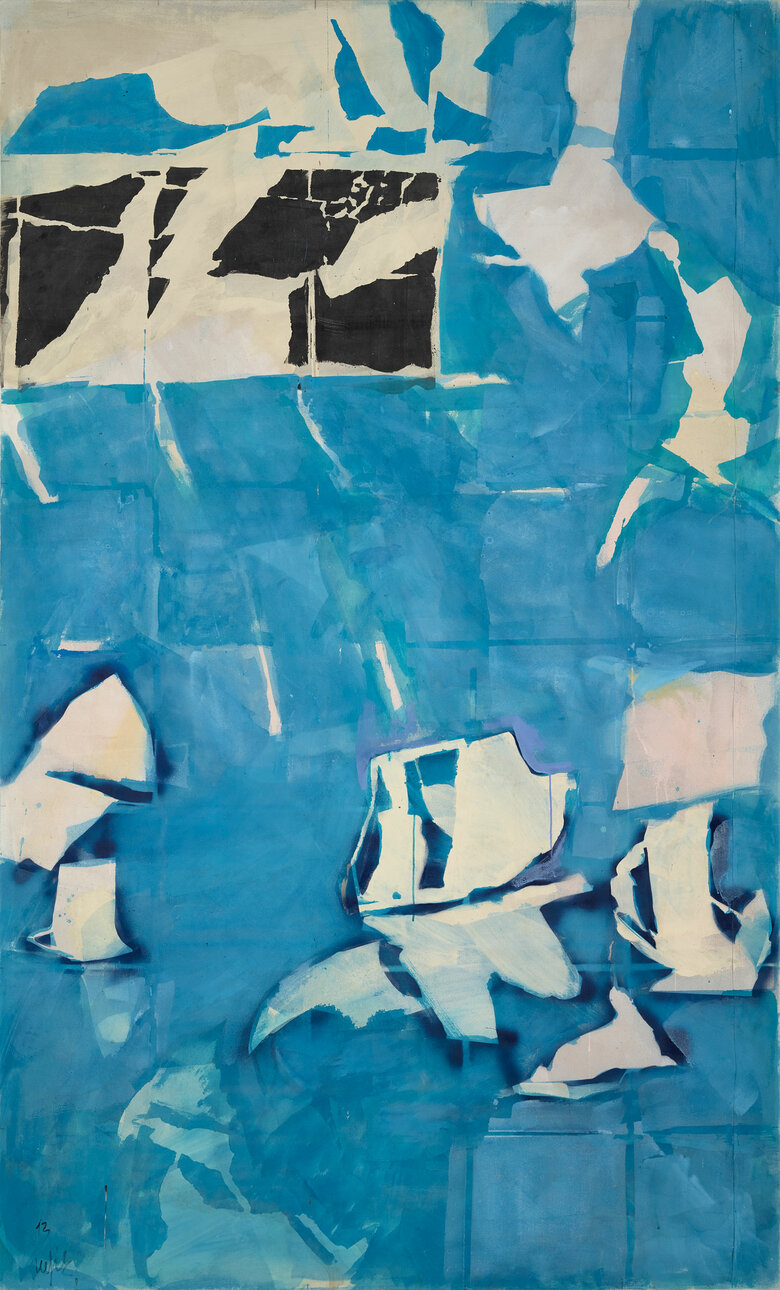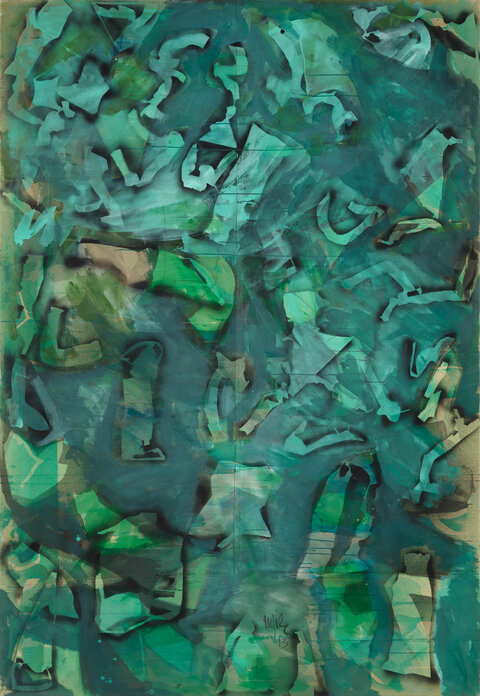Written by Layla YakoubTranslated by Fadia Antar Rafik El Kamel was born in 1944 in Tunis. He graduated from the Institut supérieur des Beaux-Arts in Tunis in 1966 and the École des Arts...
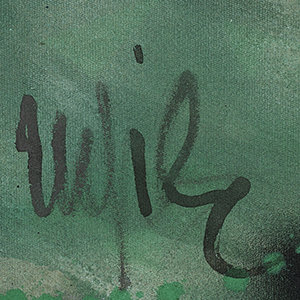

RAFIK EL KAMEL, Tunisia (1944)
Bio
Written by Layla Yakoub
Translated by Fadia Antar
Rafik El Kamel was born in 1944 in Tunis. He graduated from the Institut supérieur des Beaux-Arts in Tunis in 1966 and the École des Arts Décoratifs in Paris in 1970. El Kamel returned to Tunisia in 1971 and taught at his alma mater while building his artistic career.
The Tunisian art scene, in the 1960s, was dominated by the School of Tunis, an anti-colonial arts movement that drew from popular sources in an effort to develop an “authentically Tunisian” national art. El Kamel and many of his peers, known as the “Nouvelles Conceptions” (New Conceptions) generation, were alienated from this group by virtue of their European educations and rejected what they saw as the School’s insular emphasis on folklore. El Kamel went abroad to pursue more experimental art practices, traveling to Paris on a scholarship from the Tunisian Ministry of Culture in 1967 to join the Department of Monumental Art at the École des Arts Décoratifs. For the next four years, he fostered his intellect and art in Paris, frequenting the studio of Jacques Despierre. He also developed a passion for Picasso and met thinkers such as Jean-Paul Sartre and Alain Krivine, with whom he participated in the May 1968 movement.
When El Kamel returned to Tunisia in 1971, he was eager to make his mark on the new Tunisian art scene. In 1976, he helped establish the IrtissemGallery, a space for artistic research and, according to its manifesto, “a meeting point of all tendencies whose essential purpose is to endow present Tunisia with specific and contemporary art.” Irtissem held an essential place in Tunisian artistic production until its closing in 1982. El Kamel contributed to many different facets of Tunisian culture throughout the 1970s and 1980s, and his involvement in the arts was not limited to any one medium or sphere. For example, his relationship with director Fadhel Jaziri and the Théâtre Nouveaucollective heavily influenced the production of El Aouada, 1989, a play whose set was inspired by El Kamel’s Vapeurs(1986), a series of paintings of Tunisian bars.
In a context where figuration was the norm, El Kamel distinguished himself through abstraction. He chose to express himself through form and color, free from concerns of reproducing the tangible. For El Kamel, the elements of chance and intuition were central to the artistic process, as is seen in the variety of forms and haphazard compositions he created. Made with acrylic paint on canvas and later, collage, his gradient and, monochromatic abstractions are composed of peaceful and deep colors, sometimes populated by small units evocative of cellular organisms. Despite collage’s association with intuition and chance, it pulled El Kamel’s work towards figurative art. The artist exhibited a memorable series of his collages at the Sidi Bou Said municipality gallery in 1984 titled La Kharja, named after a procession held in honor of a Sufi saint.
It was thus in the mid-1980s that El Kamel adopted figuration. In 1986, barely a year after partaking in a group exhibition on abstraction, he exhibited new figurative works at the Gorgi Gallery. He never abandoned abstract art, but rather helped deconstruct the strict opposition between abstract and figurative categories. El Kamel appointed a central role to color and light effects in his new approach, which deemphasized the actual object of representation in favor of the structure and composition created by shadow and light. Repeated colorful depictions of the same subject in his series Fou Rire(1985), evoke the pop art portraits that made Andy Warhol’s career twenty years earlier.
By representing the real, El Kamel confronted the challenges and theoretical debates of his time: he deliberated on what to paint and how to paint as a Tunisian artist while drifting away from Orientalism, and avoiding a futile search for universality. El Kamel answered this debate by painting the contemporary portrait of his personal Tunisia; its streets rendered both historical and contemporary. His works portray quotidian scenes of leather jackets, floral skirts, and traditional headgear alongside table football players, partygoers, and shoe shiners. By transcending this binary without caricature, nostalgia, or over-intellectualization, El Kamel leaves a specific and striking trace in the history of modern Tunisian art.
Rafik El Kamel lives and works in Cape Bon, Tunisia.
Sources
Lasram, Zoubeïr. Rafik El Kamel. Tunis: Cérès Productions, 1992.
Louati, Ali. L'aventure De L'art Moderne En Tunisie. Tunis: Simpact éditions, 1997.
"Rafik El Kamel." Répertoire Des Artistes Tunisiens. September 24, 2016. Accessed June 08, 2018. http://repertoire-artistestunisiens.com/rafik-el-kamel/.
محمد مھدي حمیدة. "الفنان التونسي رفيق الكامل.. من التجريدية إلى الكولاج." صحيفةالخليج.February 22, 2016. Accessed June 08, 2018. http://www.alkhaleej.ae/home/print/f53c9315-c755-48f7-a351-9dc93baa2e5a/42ffa860-3f7d-4b63-ae4a-fea8d7c1f05c.
المصباحي, حسونة. "تشكيلي تونسي آثر العزلة ليرسم ألوانه الخاصة." صحيفة العرب.February 22, 2017. Accessed June 08, 2018. https://alarab.co.uk/تشكيلي-تونسي-آثر-العزلة-ليرسم-ألوانه-الخاصة.
"معرض الرسام الكبير رفيق الكامل برواق الكمان الازرق بسيدى بوسعيد." تورس.November 26, 2009. Accessed June 08, 2018. https://www.turess.com/tap/9672.
"عندماتحو'الشكوك." الصّحافة. October 30, 2017. Accessed June 08, 2018. http://www.essahafa.tn/index.php?id=118&tx_ttnews[tt_news]=62736&tx_ttnews[backPid]=33&cHash=607ffb4009.
"معرض الفنان ا ربعة الكبار : الفن التونسي الحديث يفرق ب التجريد والتشخيص." Alhayat. October 6, 1999. Accessed October 30, 2017.http://daharchives.alhayat.com/issue_archive/Hayat INT/1999/10/6/معرض-الفنان -ا ربعة-الكبار-الفن-التونسي-الحديث- -يفرق-ب -التجريد-والتشخيص.html.
CV
Selected Solo Exhibitions
2016
Le Violon Bleu Gallery, Sidi Bou Saïd, Tunisia
2012
Kalysté Gallery, Ariana, Tunisia
2009
Transfigurations, Le Violon Bleu Gallery, Sidi Bou Saïd, Tunisia
1990
Ammar Farhat Gallery, Sidi Bou Saïd, Tunisia
1989
Espace Sophonisbe, Carthage, Tunisia
1987
Frégnac Gallery Paris, France
1986
Gorgi Gallery, Tunis, Tunisia
1984
Sidi Bou Saïd Museum, Sidi Bou Saïd, Tunisia
1982
Renate Seeger Gallery, Munich, Germany
1980
Frégnac Gallery, Paris, France
1979
Irtissem Gallery, Tunis, Tunisia
1976
Irtissem Gallery, Tunis, Tunisia
1966
German Cultural Center, Tunis, Tunisia
Galerie Yahia, Tunis, Tunisia
Selected Group Exhibitions
2022
Untitled 2, Selma Feriani Gallery, Tunis, Tunisia
2020
Untitled, Selma Feriani Gallery, Tunis, Tunisia
Welcome Home Vol. II, Museum of African Contemporary Art Al Maaden, Marrakech, Morocco
2018
Maghreb-Orient des livres, Salon, Hôtel de Ville de Paris, Paris, France
Les contemporains du passé, Le Violon Bleu Gallery, Sidi Bou Saïd, Tunisia
2017
E-Mois, autobiographie d’une collection, Museum of African Contemporary Art Al Maaden (MACAAL), Marrakech, Morocco
Petits formats, Saladin Gallery, Sidi Bou Saïd, Tunisia
2016
Tajrid(Abstraction), Musée de la ville de Tunis, Tunisia
Passerelles, Attijari Bank North Urban Center, Tunis, Tunisia
Masters du monde arabe, Le Violon Bleu Gallery, Sidi Bou Saïd, Tunisia
2014
Solid’ART, Mövenpick Hotel Gammarth, Tunisia
2013
Tajreed, CAP Kuwait, Kuwait
2010
Tunisian Pavilion, World Expo Shanghai, Shangai, China
2003
La lettre brisée, museum of Darmstadt, Darmstadt, Germany
2002
Perspectives on Contemporary Arab Art, Kinda Foundation Collection, Arab World Institute, Paris, France
1999
Quatre artistes tunisiens, Wallonie-Bruxelles Centre, Bruxelles, Belgium / Paris, France / Tunis, Tunisia
1995
Regard sur l’art contemporain tunisien : Meriem Bouderbala, Rafik el Kamel, Jellel Gasteli, Ahmed Hajeri, Abderrazak Sahli, Musée-unité d’Art Contemporain, Institut du Monde Arabe, Paris, France
1993
Peintres du Maghreb, Consorcio de la Ciudad de Santiago de Compostela, Santiago de Compostela, Spain
Méditerranée, jeux de lumière, Ephèbe Museum, Cap d’Agde, France
Château de Servière, Marseille, France
1991
Ammar Farhat Gallery, Sidi Bou Saïd, Tunisia
1990
3 peintres maghrébins, Chuman Foundation, Jordan
1989
3 peintres maghrébins, Hippodrome de Douai, Douai, France
1988
Quatre peintres Arabes, première : Azzaoui, El Kamel, Kacimi, Marwan, Arab World Institute, Paris, France
1987
National Museum of Arts of Africa and Oceania, Paris, France
1986
Rond-Point Theatre, Paris, France
Museum of Modern Art of Villeneuve-d'Ascq, Villeneuve-d’Asq, France
1985
Kuwait exhibition For Arab Artists, Kuwait, Kuwait
Gorgi Gallery, Tunis, Tunisia
Centre National d'Art Vivant de Tunis, Tunisia
1984
Centre National d'Art Vivant de Tunis, Tunisia
1981
Irtissem Gallery, Tunis, Tunisia
1977
Youth Biennale, Palais de Tokyo, Museum of Modern Art of the City of Paris, Paris, France
1974
Irtissem Gallery, Tunis, Tunisia
1971
School of Tunis, Tunis, Tunisia
1970
International City of Art, Paris, France
May Fair, Paris, France
UNESCO Palace, Paris, France
1967
School of Tunis,Tunis, Tunisia
Awards and Honors
1985
First prize at the Kuwait Exhibition for Arab Artists
1984
First prize for the annual exhibition of contemporary art
First prize of the city of Tunis
Collections
The Khalid Shoman Foundation: Darat Al Funun, Amman, Jordan
Jordan National Gallery of Fine Arts, Amman, Jordan
Institut du Monde Arabe, Paris, France
Kamel Lazaar Foundation, Tunis, Tunisia
Kinda Foundation Collection, Riyadh, Saudi Arabia
Museum of African Contemporary Art Al Maaden (MACAAL), Marrakech, Morocco
Villeneuve-d’Ascq Modern Art Museum, Villeneuve-d’Ascq, France
Ramzi and Saeda Dalloul Art Foundation, Beirut, Lebanon
Press
الصّحافة_ عندما تحوم الشكوك.pdf
JetSetMagazine.pdf
معرض الفنانين الأربعة الكبار _ الفن التونسي الحديث لا يفرق بين التجريد والتشخيص .pdf
AlArab.pdf
تورس _ معرض الرسام الكبير رفيق الكامل برواق الكمان الازرق بسيدى بوسعيد.pdf
FemmesdeTunisie.pdf
الفنان التونسي رفيق الكامل.. من التجريدية إلى الكولاج.pdf
Rafik El Kamel_ Un livret en hommage à l’artiste-peintre.pdf
RAFIK EL KAMEL Artwork
Become a Member
Join us in our endless discovery of modern and contemporary Arab art
Become a Member
Get updates from DAF
Follow Artists
Save your favourite Artworks
Share your perspectives on Artworks
Be part of our community
It's Free!
We value your privacy
TermsCookiesPrivacy Policies
Become a Member
Get updates from DAF
Follow Artists
Save your favourite Artworks
Share your perspectives on Artworks
Be part of our community
It's Free!
We value your privacy
TermsCookiesPrivacy Policies
Become a Member
Get updates from DAF
Follow Artists
Save your favourite Artworks
Share your perspectives on Artworks
Be part of our community
It's Free!
We value your privacy
TermsCookiesPrivacy Policies
Welcome to the Dalloul Art Foundation
Thank you for joining our community
If you have entered your email to become a member of the Dalloul Art Foundation, please click the button below to confirm your email and agree to our Terms, Cookie & Privacy policies.
We value your privacy, see how
Become a Member
Get updates from DAF
Follow Artists
Save your favourite Artworks
Share your perspectives on Artworks
Be part of our community
It's Free!
We value your privacy
TermsCookiesPrivacy Policies

